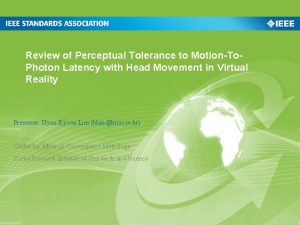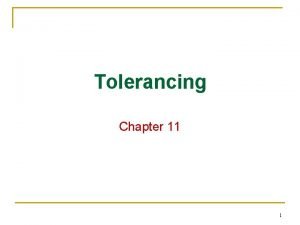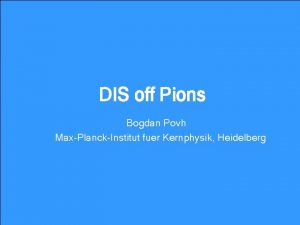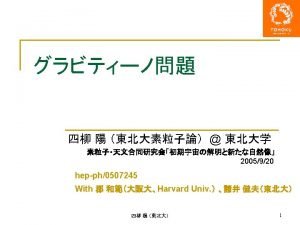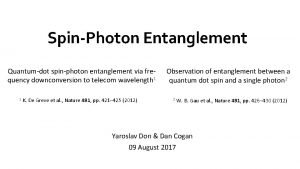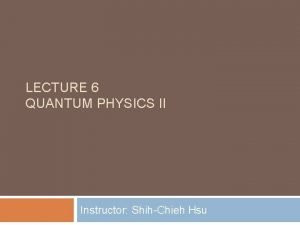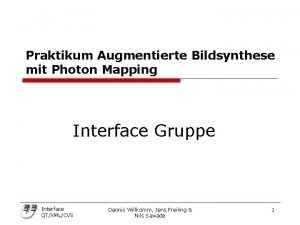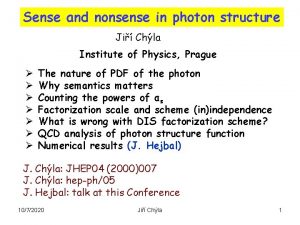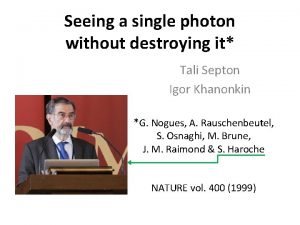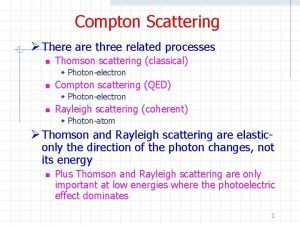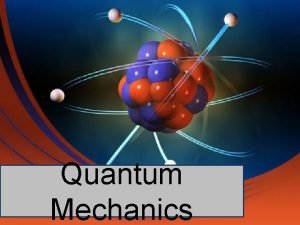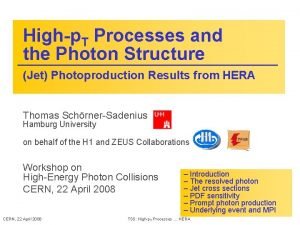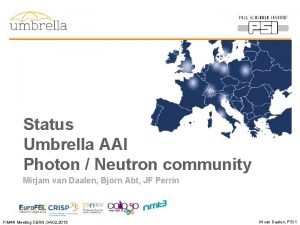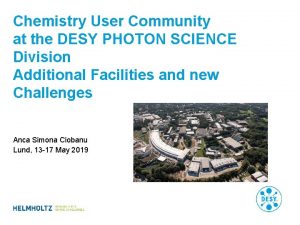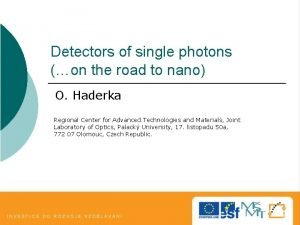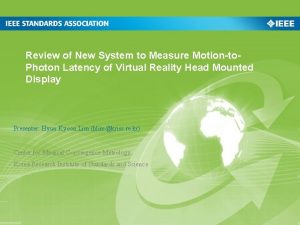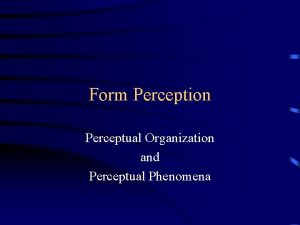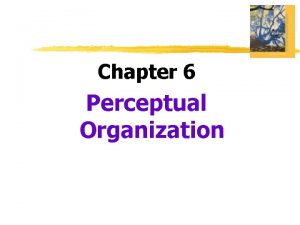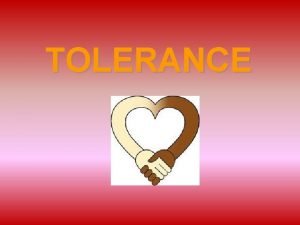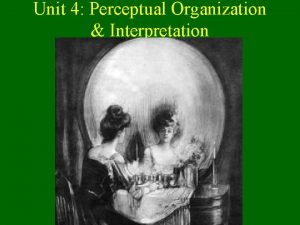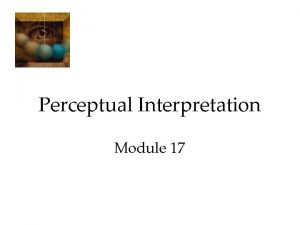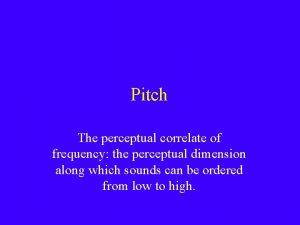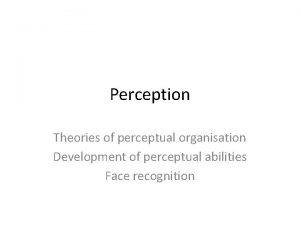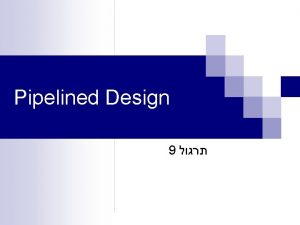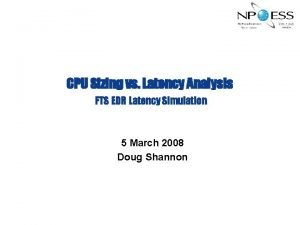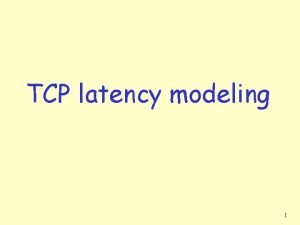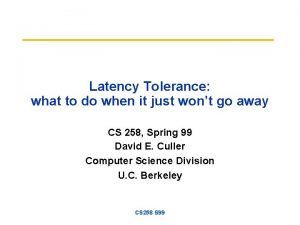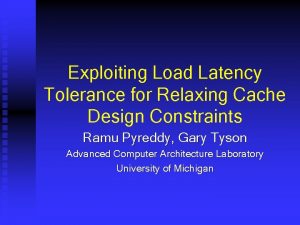Review of Perceptual Tolerance to MotionTo Photon Latency



















- Slides: 19

Review of Perceptual Tolerance to Motion-To. Photon Latency with Head Movement in Virtual Reality Presenter: Hyun Kyoon Lim (hlim@kriss. re. kr) Center for Medical Convergence Metrology Korea Research Institute of Standards and Science

Compliance with IEEE Standards Policies and Procedures • Subclause 5. 2. 1 of the IEEE-SA Standards Board Bylaws states, "While participating in IEEE standards development activities, all participants. . . shall act in accordance with all applicable laws (nation-based and international), the IEEE Code of Ethics, and with IEEE Standards policies and procedures. " • The contributor acknowledges and accepts that this contribution is subject to • The IEEE Standards copyright policy as stated in the IEEE-SA Standards Board Bylaws, section 7, http: //standards. ieee. org/develop/policies/bylaws/sect 6 -7. html#7, and the IEEESA Standards Board Operations Manual, section 6. 1, http: //standards. ieee. org/develop/policies/opman/sect 6. html • The IEEE Standards patent policy as stated in the IEEE-SA Standards Board Bylaws, section 6, http: //standards. ieee. org/guides/bylaws/sect 6 -7. html#6, and the IEEE-SA Standards Board Operations Manual, section 6. 3, http: //standards. ieee. org/develop/policies/opman/sect 6. html 3079 -20 -0011 -00 -0000 -Review of Perceptual Tolerance to Motion-To-Photon Latency with Head Movement in Virtual Reality 2

IEEE 3079 HMD Based VR Sickness Reducing Technology Dongil Dillon Seo, dillon. seo@telekom-capital. com Review of Perceptual Tolerance to Motion-To-Photon Latency with Head Movement in Virtual Reality Date: 2020 -02 -04 Author(s): Hyun Kyoon Lim Name Affiliation Hyun Kyoon Lim KRISS Sungshin Woman’s University Yonsei University KRISS Dong-A University Kyoung-Mi Jang Ye Shin Woo Dong. Hyun Lee Dong Soo Choi Phone [optional] 3079 -20 -0011 -00 -0000 -Review of Perceptual Tolerance to Motion-To-Photon Latency with Head Movement in Virtual Reality Email [optional] hlim@kriss. re. kr cest 20@gmail. com yeshin. woo@gmail. com ldh 1007@naver. com soochoi@dau. ac. kr 3

Reference: 3079 -20 -0011 -00 -0000 -Review of Perceptual Tolerance to Motion-To-Photon Latency with Head Movement in Virtual Reality 4

Abstract l Since MTP (Motion-To-Photon) latency is inevitable, it is necessary to quantify. l In this paper, 1) The effect of head movement on the threshold of MTP latency 2) To determine the acceptability of subjects for MTP latency above the threshold. l Three experiments were performed with different conditions (motion event, angle, angular velocity) • The above three influence the perception of MTP latency • Threshold for recognizing MTP latency varies according to angular velocity • MTP latency is more inconvenient in event-MTR than motion event-MSA 3079 -20 -0011 -00 -0000 -Review of Perceptual Tolerance to Motion-To-Photon Latency with Head Movement in Virtual Reality 5

Purpose l Perceptual sensitivity of MTP latency can be affected by head movements, including motion event, angle, angular velocity. Methods l MTP latency • To watch a video under head moving • The MTP latency of the system is measured to 28. 5 ms • The amount of add latency been loaded by the ring buffer • Added latency: 0, 11, 22, 33, 44, 66, 88 ms 3079 -20 -0011 -00 -0000 -Review of Perceptual Tolerance to Motion-To-Photon Latency with Head Movement in Virtual Reality 6

Methods l Head movement task • 2 motion events ① Motion-Static-Alternate (MSA): Abrupt change and movement in one direction ② Motion-To-Reverse (MTR): Instant motion in the opposite direction l 2 angles / 5 angular velocity conditions • 40 ° and 80 ° • 20, 40, 60, 80, Inf ° / s 3079 -20 -0011 -00 -0000 -Review of Perceptual Tolerance to Motion-To-Photon Latency with Head Movement in Virtual Reality 7

Methods l Experimental method on angle condition • MSA : (example) After staying at A for 2 sec, gently turn head 40°to B, and after staying at B for 2 sec, return to A. • MTR: (example) Go straight from B to A without staying 2 sec l Experimental method on angular velocity • MSA : (example) Stay at A for 2 sec, turn to B as quickly as possible. • MTR: (example) Go back to A-B-A without staying 2 sec 3079 -20 -0011 -00 -0000 -Review of Perceptual Tolerance to Motion-To-Photon Latency with Head Movement in Virtual Reality 8

Methods l Visual cueing • Red ~ blue dot : Guiding the beginning and end of the subject’s movement • Black dot : Guiding the subject to turn his head 3079 -20 -0011 -00 -0000 -Review of Perceptual Tolerance to Motion-To-Photon Latency with Head Movement in Virtual Reality 9

Materials l Video content • 5 contents : airplane, balloon, lion, studio, park – 4 k 360° l Subjects • Adult (age: 20’s) 19 (male : 11, female : 8) l Apparatus • HTC Vive head mounted display(HMD): resolution 2160 x 1200, 110° FOV, 90 Hz 3079 -20 -0011 -00 -0000 -Review of Perceptual Tolerance to Motion-To-Photon Latency with Head Movement in Virtual Reality 10

Result Ø Angles and Angular Velocities of Head Rotation 3079 -20 -0011 -00 -0000 -Review of Perceptual Tolerance to Motion-To-Photon Latency with Head Movement in Virtual Reality 11

Result Ø Perceptual Threshold of MTP Latency ü 5 -point scale: − 1 (imperceptible), 0 (uncertain), 1 (perceptible, but not annoying), 2 (annoying), 3 (very annoying) 3079 -20 -0011 -00 -0000 -Review of Perceptual Tolerance to Motion-To-Photon Latency with Head Movement in Virtual Reality 12

Result Ø The closer the color is to red, the higher the score Ø Mean opinion scores (MOS) are used to describe the central tendency. Ø The difference in MOS value changes slowly at first but then increases rapidly with increasing delay. Ø The maximum perceived threshold is 40. 70 ms at MSA, 80°and 20 °/ s Ø The minimum value is 22. 71 ms at MSA, 40 °, inf °/ s 3079 -20 -0011 -00 -0000 -Review of Perceptual Tolerance to Motion-To-Photon Latency with Head Movement in Virtual Reality 13

Result Ø Perceptual Threshold of MTP latency ü Threshold decreased in MTR than MSA § motion event, p = 0. 0022 <0. 05 ü Threshold decreases with increasing angular velocity • § In MSA: p = 0. 0003 <0. 05, § In MTR: p = 0: 0057 <0. 05 Total threshold plots against velocity : points are values of total thresholds curves are fitted model. 3079 -20 -0011 -00 -0000 -Review of Perceptual Tolerance to Motion-To-Photon Latency with Head Movement in Virtual Reality 14

Result Ø User Acceptance the over-threshold MTP latency • Normalized MOS versus added latency: points are measured MOS, curves are fitted logistic models 3079 -20 -0011 -00 -0000 -Review of Perceptual Tolerance to Motion-To-Photon Latency with Head Movement in Virtual Reality 15

Result Ø User Acceptance the over-threshold MTP latency • Normalized MOS versus added latency: points are measured MOS, curves are fitted logistic models 3079 -20 -0011 -00 -0000 -Review of Perceptual Tolerance to Motion-To-Photon Latency with Head Movement in Virtual Reality 16

Result Ø Simulator Sickness ü SSQ (Stimulator Sickness Questionnaires) before and after experiment 1) SSQ-Total score 2) SSQ-nausea 3) SSQ-oculomotor 4) SSQ-disorientation • The mean of SSQ scores with 95% CI 3079 -20 -0011 -00 -0000 -Review of Perceptual Tolerance to Motion-To-Photon Latency with Head Movement in Virtual Reality 17

Discussion l The symptoms of motion sickness worsen after the experiment. • But, the overall score is confirmed to be mild level. • Trials and rest periods within 20 minutes were thought to reduce the worsening of motion sickness. l Motion event : MTR < MSA ( all p <. 05 ) • Velocity (In MAS: p=. 0056 <. 05, In MTR: p=. 0214<. 05) • Angular velocity (In MAS: p=3. 7862 e-12 <. 05, In MTR: p=4. 1372 e-10<. 05) 3079 -20 -0011 -00 -0000 -Review of Perceptual Tolerance to Motion-To-Photon Latency with Head Movement in Virtual Reality 18

Thank you ! 19
 Motion-to-photon latency
Motion-to-photon latency Cellular and molecular immunology
Cellular and molecular immunology Unilateral tolerance and bilateral tolerance
Unilateral tolerance and bilateral tolerance Institut für kernphysik
Institut für kernphysik Lepton-photon
Lepton-photon Photon polarization
Photon polarization Photon is our business
Photon is our business Photon neutron
Photon neutron Momentum of the photon
Momentum of the photon Photon assay technology
Photon assay technology Photon mapping c++
Photon mapping c++ Photon polarization
Photon polarization Photon structure
Photon structure Single photon
Single photon Photoelectric and compton effect
Photoelectric and compton effect A photon checks into a hotel
A photon checks into a hotel Photon structure
Photon structure Mirjam van daalen
Mirjam van daalen Desy photon science
Desy photon science Photons
Photons
